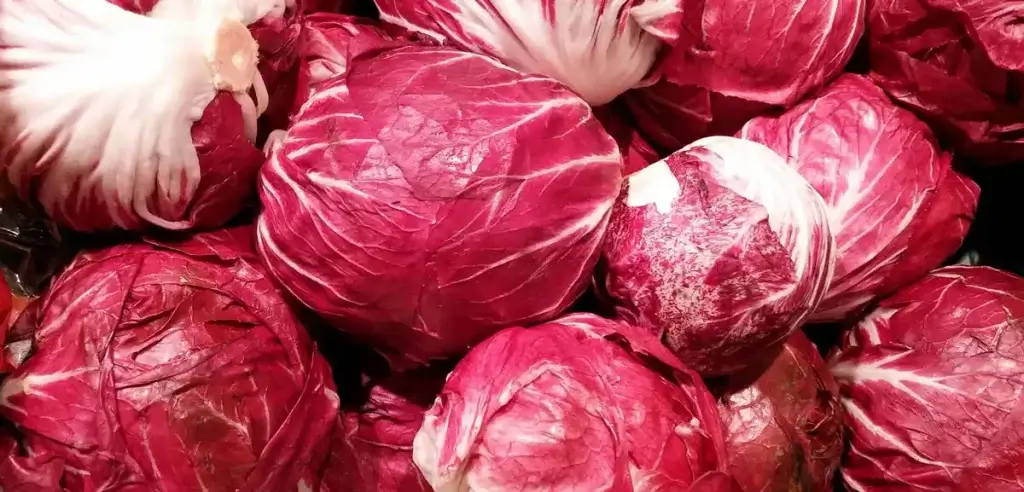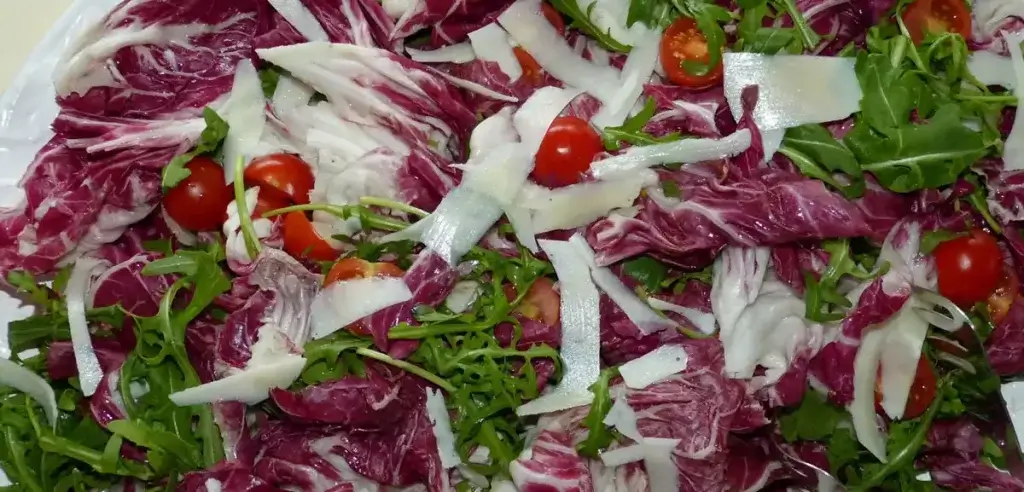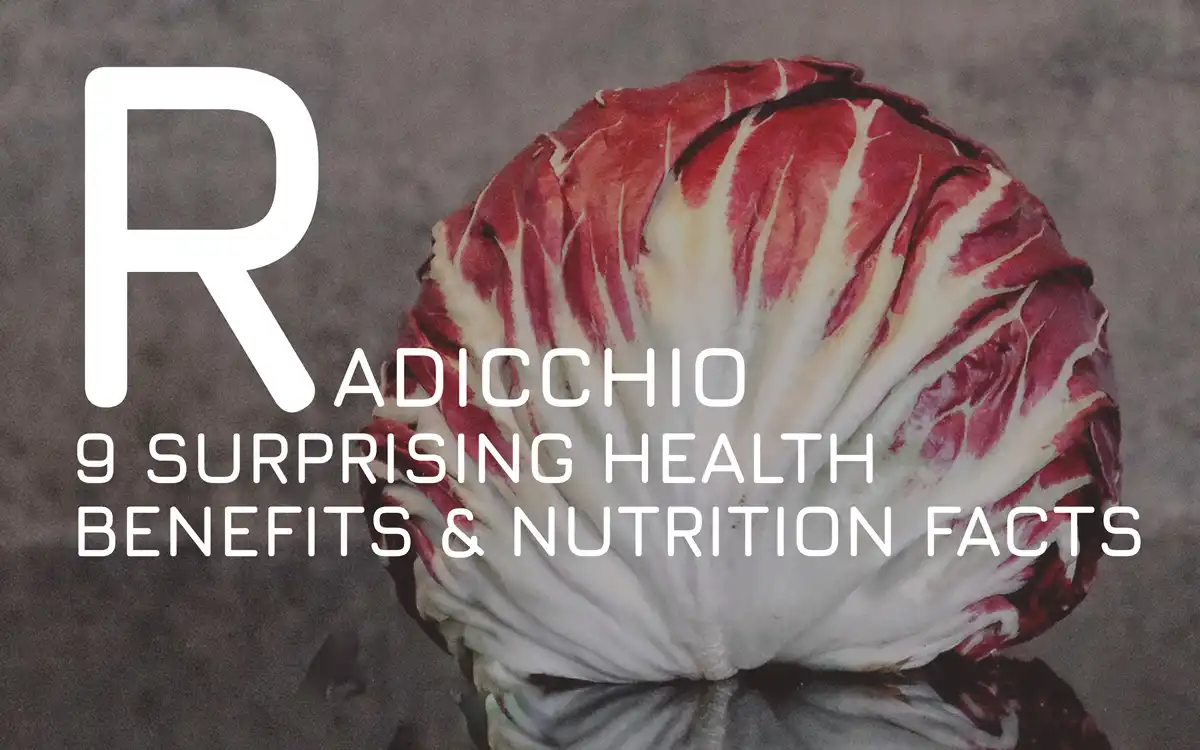9 Surprising Health Benefits of Radicchio
The health benefits of radicchio are many. Radicchio is a type of chicory that is grown in Italy. It has a slightly bitter taste and is used in salads, soups, and side dishes. Radicchio is a good source of fiber, vitamin K, and potassium. It also contains antioxidants that can help protect against disease. In this article, we will discuss the health benefits of radicchio and provide some nutritional information about this nutrient-rich vegetable.
What Is Radicchio?
Radicchio is a leafy vegetable that belongs to the Italian Chicory family. The most common variety of Radicchio is known as Red Radicchio, and it has a deep red color with white spots. It is a bitter vegetable, and it is often used in salads or as a garnish. Radicchio is a rich source of antioxidants and vitamins, and it has several health benefits.

For example, it can help to improve digestion, reduce inflammation, and lower cholesterol levels. Additionally, Radicchio is a low-calorie food, making it an ideal addition to any weight-loss diet.If you are looking for a way to add some flavor to your meals, then consider using Radicchio. It is a versatile vegetable that can be used in a variety of dishes, and it provides numerous health benefits.
Varieties
There are many different types of radicchio, ranging in size, shape, and color. The most popular variety is Radicchio di Chioggia, which has spherical leaves and white veins. This type of radicchio is bitter in flavor and is often used in salads or as a garnish. Another popular variety is Radicchio di Triviso, which has a sweet and tart flavor that makes it ideal for grilling or barbecuing. Finally, Radicchio di Castelfranco is a softer variety that is best used in salads. Regardless of the type of radicchio you choose, it will add a unique flavor to your dish.
The plant
The plant is native to Europe and was first cultivated in Italy. The most common variety of radicchio is red, but it can also be found in white, green, and purple. Radicchio is available year-round, but it is at its peak from October to February. When choosing radicchio, look for crisp leaves with no signs of browning or wilting.
Avoid any blemishes or bruises. Radicchio can be stored in the refrigerator for up to a week. To prepare it, simply wash the leaves and chop them into bite-sized pieces. It can then be added to salads or used as a garnish.
Radicchio Nutrition Facts
Nutritionally, radicchio is an excellent source of dietary fiber. It is also a good source of vitamins A and C, potassium, and folate. Additionally, radicchio contains a type of antioxidant known as anthocyanins, which have been linked to various health benefits. When searching for radicchio at the grocery store, look for heads that are heavy for their size and free
100 grams of raw radicchio contain the following nutrients:
- 23 calories
- 4.5 grams carbohydrates
- 0.25 grams fat
- 1.43 grams protein
- 0.9 grams fiber
- 255 micrograms Vitamin K (210% of RDI)
- 0.34 milligrams copper (35% of RDI)
- 60 micrograms Vitamin B9 – folate (28% of RDI)
- 2.3 milligrams vitamin E (15% of RDI)
- 8 milligrams Vitamin C (10% of RDI) vitamin c
- 302 milligrams potassium (10% of RDI)
- 0.6 milligrams iron (7% of RDI)
- 0.13 milligrams manganese (7% of RDI)
- 0.6 milligrams zinc (6% of RDI)
- 40 milligrams phosphorus (6% of RDI)
- 0.27 milligrams Vitamin B5 – pantothenic acid (5% of RDI)
- 13 milligrams magnesium (5% of RDI)
- 0.06 milligrams Vitamin B6 (4% of RDI)
- 0.03 milligrams Vitamin B2 – riboflavin (2% of RDI)
- 0.25 milligrams Vitamin B3 – niacin (2% of RDI)
- 0.02 milligram Vitamin B1 – thiamin (2% of RDI)
- 19 milligrams calcium (2% of RDI)
- 0.9 micrograms Selenium (2% of RDI)
- 22 micrograms Sodium (2% of RDI)
- 1 microgram Vitamin Α (>1% of RDI)
- 16 micrograms Carotene, beta
9 Health Benefits of Radicchio
It is a good source of nutrients, including fiber, potassium, and vitamins A and C. Additionally, radicchio contains compounds that may offer health benefits, such as antioxidants and anti-inflammatory properties. Studies have shown that these compounds may help to protect against certain chronic diseases, such as heart disease and cancer. Additionally, the fiber in radicchio can help to promote digestive health and potassium can help to regulate blood pressure. Overall, radicchio is a nutritious vegetable that offers several potential health benefits.
1. Helps and improves the Immune system
Radicchio is a leafy vegetable that many believe can help improve immunity. The vegetable is also an excellent antiseptic and antioxidant. In addition, radicchio has been shown to reduce inflammatory conditions and inflammation.
The beneficial properties of radicchio are attributed to the presence of polyphenols, including zeaxanthin and lutein. These substances work together to boost the immune system and protect the body against disease. Furthermore, the antioxidants in radicchio help to neutralize harmful free radicals, which can damage cells and lead to various health problems.
2. Improves bone health and bone mineral density
Radicchio is an excellent source of vitamin K, a nutrient that plays an important role in bone health. Vitamin K helps your body to build and maintain strong bones by aiding in the mineral synthesis process and promoting blood clotting and repair. Furthermore, by helping to prevent bone damage and reduce inflammation, vitamin K can also protect against bone diseases such as osteoporosis.
3. Reduces the risk of Alzheimer’s Disease
Radicchio is a dark leafy vegetable that is rich in antioxidants. According to a report antioxidants may help to reduce inflammation in the nervous system and slow down the damage caused by Alzheimer’s disease. Radicchio is also a good source of vitamin K, which is essential for cognitive health.
Vitamin K has been shown to improve brain function and protect against age-related mental decline. In addition, radicchio contains phytonutrients that have been shown to protect against cell damage and promote brain health. These properties make radicchio an excellent food for reducing the risk of Alzheimer’s disease.
4. Ideal food for those wanting to lose weight
Radicchio is low in calories and high in fiber, making it an ideal food for those wanting to lose weight. The fiber content of radicchio helps to keep you feeling full, while the low-calorie count means that you can enjoy it without fear of packing on the pounds. In addition, radicchio contains a compound called quercetin, which has been shown to boost metabolism and promote weight loss. So if you’re looking for a way to add more flavor and nutrition to your diet while still staying on track with your weight loss goals, radicchio is a great option.
5. Important for promoting bowel function
Radicchio is a good source of fiber, which is important for promoting bowel function. Fiber helps to bulk up the stool and stimulates peristaltic contractions, which help to move food through the digestive system. In addition, fiber helps to prevent the symptoms of constipation, bloating and flatulence. While most people get enough fiber from their diet, those who do not may benefit from including radicchio in their diet.
6. Detoxifies the Body
It is an excellent source of antioxidants and vitamins K, C, and E. Radicchio also contains flavonoids, which are known to have potent detoxifying properties. Studies have shown the benefit of radicchio in stimulating liver functions, speeding resorption of nutrients from the body, and removing excess blood. These health benefits make radicchio an ideal food for people who are looking to detoxify their bodies and improve their overall health.
7. Reduced risk of cancer and has cancer-killing benefits
It contains compounds that can help to protect against cancer. For example, the vegetable is rich in polyphenols, including glutathione and zeaxanthin. These compounds help to reduce oxidative stress throughout the body, which can damage cells and contribute to the development of cancer.
For people with liver cancer, incorporating radicchio into their regular diet may be beneficial. Studies have shown that the antioxidants present in this vegetable can help to fight against a common type of liver cancer known as Hep-G2.
It is shown that when the chicory plant is grown without exposure to pesticides, the levels of antioxidants are higher, making it an ideal choice to purchase organic radicchio whenever possible. Including this vegetable as part of a regular meal plan may help to improve the prognosis for those with liver cancer.
A recent study revealed that an extract of chicory has a powerful impact on colon cancer, especially in the early phases. According to the study, radicchio’s plant-based sugars, known as fructans, may help prevent and/or reduce colon cancer. This is an exciting finding, as it provides a potential natural way to reduce the risk of this disease.
In addition to its potential effects on colon cancer, radicchio also contains one of the highest amounts of vitamin K in one serving that you can find. Vitamin K is known to reduce the risk of oral, colon, prostate, stomach, and nasal cancers. Therefore, consuming radicchio may help to reduce your overall risk of developing cancer.
In addition, radicchio contains sulforaphane, a compound that has been shown to kill cancer cells in test-tube studies.
8. Regulates blood pressure and improves heart health
It has been shown to offer heart-protective benefits, according to a rat study. On damaged hearts, researchers discovered that chicory, which is a type of radicchio, reduced high blood pressure, decreased cholesterol levels, inflammation, and lesion size.
These effects are likely due in part to the fact that radicchio is a good source of vitamin K. This vitamin is particularly important for preventing the calcification of arteries, which leads to hardening and narrowing of the vessels. It also aids in inhibiting the development of blood clots, inflammation in cells throughout blood vessels, and healthy blood pressure.
In addition, it is rich in antioxidants and potassium, making it a heart-healthy food. The potassium that it contains has been shown to lower blood pressure by helping the body get rid of excess sodium. Consequently, including radicchio in your diet may help to protect against cardiovascular disease.
9. Improves vision and reduces the risk for macular degeneration
Lutein and zeaxanthin are two nutrients that have long been considered effective at preventing macular degeneration, a leading cause of blindness. Both nutrients are found in high concentrations in the retina, and they work to filter out harmful blue light.
Studies have shown that people who consume high levels of lutein and zeaxanthin are at lower risk for macular degeneration. Radicchio is a good source of both nutrients, and it also contains other antioxidants that may help to protect the eyes.
What to look for when buying Radicchio?
When purchasing Radiccio, there are a few key factors to consider in order to ensure that you are getting a high quality product. First, look for Radiccio that is deep purple in color. Avoid any heads that are brown or have wilted leaves, as these will not be as fresh. Second, feel the Radiccio to make sure that it is firm and weighs heavy for its size.
A softer head will be past its prime and will not have as much flavor. Finally, take a sniff of the Radiccio before buying it; it should have a pleasantly pungent aroma. If it smells off or has very little scent, it is likely past its peak. By keeping these factors in mind, you can be sure to choose a delicious and fresh head of Radiccio.
When it’s Best?
Radicchios are usually harvested during the summer or autumn/winter, and their season of harvest may influence their flavors. When harvested during summer, radicchios tend to have a nutty bitter taste, while radicchios harvested from autumn/winter are often milder and even sweet. Look for radicchios which have bright colors, firm foliage, and no yellowing on leaves.
The compact head indicates the freshness of the radicchio. Should leaf color fade in limp condition, then choose a different leaf type for each.
Storage and food safety
Proper storage is key to maintaining food safety. Radicchio, in particular, should be kept in the refrigerator until ready for use. This is because radicchio will stay warm during winter, and this can lead to bacteria growth if the fruit is not stored properly.
Additionally, radicchio can be stored in a plastic container wrapped in plastic wrap or in sealed bags containing paper towels. These paper towels help absorb moisture and keep the radicchio fresh and crisp. Finally, if you do not wash the radicchio after use, this will help reduce moisture. Radicchio can be stored for three or more days without freezing.
However, it is important to only purchase radicchio at the price you intend on using. This will help ensure that you do not end up with radicchio that has been stored for too long and is at risk of bacterial growth.
How to use radicchio (Recipes)
While it may look unassuming, radicchio is a versatile and flavorful ingredient that can add a touch of elegance to any dish. Its deep red leaves are packed with nutrients, and its slightly bitter taste adds depth and dimension to both cooked and raw dishes.

In Italy, radicchio is often used in salads, but it can also be grilled, roasted, or sautéed. For a simple yet stunning salad, combine radicchio with avocado, orange slices, and a light vinaigrette. Or, mix radicchio with other greens, such as spinach or arugula. Add some chopped veggies, like carrots or cucumbers, and top with your favorite dressing.
For a more substantial dish, grilled radicchio makes an excellent accompaniment to steak or chicken. Roasting radicchio brings out its natural sweetness, making it a perfect side for roasted meats or vegetables.
You can also add radicchio to pasta dishes or pizza. The slightly bitter taste of radicchio pairs well with other bold flavors, such as garlic or olives. No matter how you choose to use it, radicchio is sure to add a unique and delicious flavor to your next meal.
Risks and Side Effects
While radicchio is generally safe to eat, there are some risks and side effects associated with it. It may cause allergic symptoms in some people, and it should be avoided by pregnant women due to its lack of safety data.
Additionally, non-bio radicchio plants can accumulate high levels of nitrates, which can be harmful if consumed in large quantities. Therefore, it is important to speak with a doctor before consuming chicory, particularly if you have a history of allergies or you are pregnant.
Final Thoughts
Radicchio is a nutrient-rich vegetable that offers a variety of health benefits. It is an excellent source of fiber, vitamins, and minerals. Additionally, radicchio contains phytochemicals that promote good health.Radicchio is also low in calories and fat, making it an ideal food for those who are trying to lose weight or maintain a healthy weight. including radicchio in your diet is a great way to improve your overall health. So, what are you waiting for? Start adding this delicious and nutritious vegetable to your meals today!
FAQs
By NutriWins team










